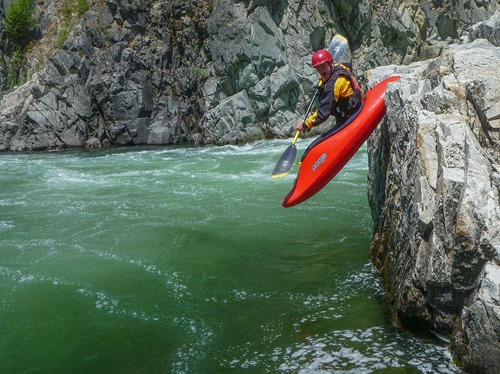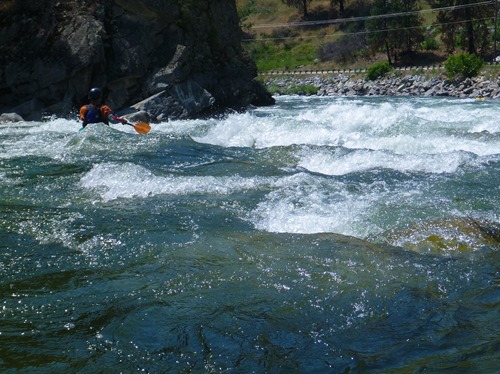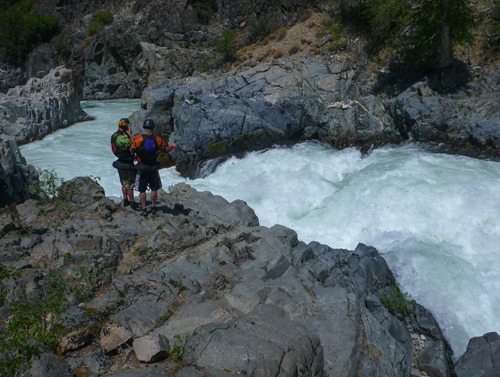 One of River’s dog bowls was riding shotgun in the van with an old black sock draped over its edge dripping water onto the carpet. Just moments prior, I dipped the sock into the bowl’s water and used it as a makeshift washcloth to soak my shirtless body with moisture that evaporated in just a few minutes. Wind roared through the open windows with a decibel rating comparable to a jet aircraft and a temperature that felt like the jet’s exhaust. Little did I know, but Idaho was beginning to experience a record setting heat wave and I was driving my 1985 VW van sans-A/C squarely into the center of the oven.
One of River’s dog bowls was riding shotgun in the van with an old black sock draped over its edge dripping water onto the carpet. Just moments prior, I dipped the sock into the bowl’s water and used it as a makeshift washcloth to soak my shirtless body with moisture that evaporated in just a few minutes. Wind roared through the open windows with a decibel rating comparable to a jet aircraft and a temperature that felt like the jet’s exhaust. Little did I know, but Idaho was beginning to experience a record setting heat wave and I was driving my 1985 VW van sans-A/C squarely into the center of the oven.
Earlier in the day, I departed the picture-perfect Tetons of Wyoming in search of new whitewater kayaking adventures in Idaho. After cresting Teton Pass, I found myself in the next state of exploration with the arid lowlands of southern Idaho replacing the lush Teton mountainscape. The drive began innocently enough, but by midafternoon when I stopped for a break at Hell’s Half Acre, the foreboding landscape served as a definite warning of the inferno I was about to experience. Although lesser known than Craters of the Moon National Monument, the magma flows that shaped the sharp, fragmented land in Biblical times were the same in both locations. The rest stop’s decrepit sun shelter and picnic table afforded some welcome shade and a chance to sip an ice-cold Keystone Light, but soon enough I began the push west again and the wet sock resumed its duties as my Vanagon air conditioner.
With nonexistent cell service and no towns with a bank’s familiar temperature readout, I proceeded ignorantly forward on my journey unaware of the temperature. The day progressed and my energy waned quickly as my left arm roasted in the sun like a 50’s dump truck driver. It wasn’t until 8pm that I thought to check the temperature in the van and was shocked to discover the 100 degree reading. My body was sapped and my spirit was demoralized from the scorching drive, so when I rolled through Boise, it was an easy decision to check into a Motel 6 that offered a cold shower and air conditioning. It was only then that I learned that the temperature had been 104 earlier in the day and would reach a record-setting 108 degrees the next day.
 Surely enough, the mercury rose to uncomfortably high levels the next few days, but by that time I was paddling the Payette Rivers to the north. On the first of July, I reunited with Cindy and Stacey at the confluence of the North and South Forks of the Payette River and proceeded to build a cool, tarped shelter for River dog before following the road along the South Fork for a few miles to the put-in of the Staircase section. As it turned out, our arrival to Idaho was a bit late for the peak run-off, so there was only about 2000 cfs flowing through each of the Payette forks. But we were from Colorado and accustomed to flows measuring in the single hundreds of CFS on our creeks, so just having the opportunity to paddle some new runs was still a joy. Upon entering the water, two qualities of the Idaho rivers were made immediately apparent to us—warmth and clarity. Where ever we traveled in Idaho, the water was much warmer than our usual Colorado snowmelt, and I quickly discovered that my drysuit was never going to make an appearance during the road trip. And just as impressive, the crystal clear river water often looked shallow but upon inspection was found to be far deeper than our Colorado runs. Even as warm water, the river provided welcome relief to the high air temperatures as we progressed through the quick run that was highlighted by the namesake Staircase rapid.
Surely enough, the mercury rose to uncomfortably high levels the next few days, but by that time I was paddling the Payette Rivers to the north. On the first of July, I reunited with Cindy and Stacey at the confluence of the North and South Forks of the Payette River and proceeded to build a cool, tarped shelter for River dog before following the road along the South Fork for a few miles to the put-in of the Staircase section. As it turned out, our arrival to Idaho was a bit late for the peak run-off, so there was only about 2000 cfs flowing through each of the Payette forks. But we were from Colorado and accustomed to flows measuring in the single hundreds of CFS on our creeks, so just having the opportunity to paddle some new runs was still a joy. Upon entering the water, two qualities of the Idaho rivers were made immediately apparent to us—warmth and clarity. Where ever we traveled in Idaho, the water was much warmer than our usual Colorado snowmelt, and I quickly discovered that my drysuit was never going to make an appearance during the road trip. And just as impressive, the crystal clear river water often looked shallow but upon inspection was found to be far deeper than our Colorado runs. Even as warm water, the river provided welcome relief to the high air temperatures as we progressed through the quick run that was highlighted by the namesake Staircase rapid.
The next day, Peter rejoined us and we explored a run farther up the South Fork of the Payette that is appropriately called the Canyon stretch. Compared to the relatively short runs we had been doing previously, the Canyon section coursed through a very deep, isolated gorge for 13 miles. The first 4 miles were gentle Class 2 that led to Pine Flats campground that featured a sandy beach and cliff-hugging hot springs next to the river that I would love to visit again the next time I am in the area. Rapids soon followed but were a really friendly pool-drop variety that inspired confidence. After 6 miles, we were met with two signs—one said, “DANGER: Big Falls 400 Yards, Portage Left” and the second said, “Big Falls Portage Here”. While rapids have often been given names that overstated their importance or danger, Big Falls was aptly named. As our jaws hung slack looking at the rapid, we all commented to each other about the criticality of making the eddy at the portage sign and considered the poor souls who would dare attempt the drop at that level. Eventually, we stopped staring at the multi-tiered, frothing white beast, and one-by-one seal-launched back into the river and continued on our way.
Several of the subsequent rapids had a real Class 4 feel to them, including Blackadar rapid that famously claimed the life of whitewater legend Walt Blackadar. After having tackled some of the toughest rivers and rapids on the planet, Walt surrendered his life in his home state when a massive log blocked his path across the river. But without any strainers to contend with, the drop was just good fun as was Lone Pine rapid downstream. Eventually, we reached a horizon line across the whole river and instantly knew that we were at Little Falls. You can’t even really say that it was like the little brother to Big Falls, since it was definitely runnable despite demanding respect. We all boofed off a 5 foot flake on the left side of the drop in order to avoid the massive pour-over hole that occupied 90% of the river width. With smiles on our faces, we continued on to the final rapid of significance—Surprise. One thing I’ve learned about whitewater is that if there is a rapid called Surprise, pay attention and give it some respect, since it will probably try to reach out and smack you! Well, at the level we ran it, Surprise Rapid was just a lot of fun with big wave drops and maybe a hole or two to avoid. After almost 4 hours, we reached the take-out and enjoyed celebratory beers in the hot sun. The combination of wilderness-feel, long duration, and great rapids all combined to earn the Canyon section top marks for our entire paddling group for the whole road trip!
Surprisingly, even after a 13 mile run, our day was far from over. We cruised up along the North Fork of the Payette River that features some famous (infamous) stretches of water that are among the most significant roadside rapids in the U.S. My entire knowledge of the river had been gleaned in numerous viewings of the movie Wildwater. So when Peter asked if I was interested in joining him and the Donnelly’s on one of the lower stretches, my answer was a definite no. Peter, 12 year old Sage, and her dad, Matt all impressed us with their run down the Warm Up stretch of the river, and then we were back in our vehicles going upstream to the town of Cascade where we arrived at Kelly’s Whitewater Park which served as our paddling destination for the next few days…
Back to Road Trip 2013 Main Page
Read the previous Road Trip 2013 article, A Week in Wyoming
Continue reading Road Trip 2013 with the next article, Kelly’s Whitewater Park
Check out a sampling of photos in the gallery below:
Click here to open the photo album in its own window


[…] Continued from Road Trip 2013: Sweltering in Idaho […]